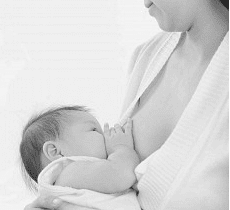For most women, breastfeeding is a given. Get pregnant. Give birth. Breastfeed. But what happens if you can’t breastfeed or choose not to breastfeed for personal reasons? Or what happens if you fully intend to breastfeed, but stop just days or weeks after starting?
In the US, 80% of moms start breastfeeding in the hospital, but only 30% are still breastfeeding baby exclusively at 3 months despite a recommendation by the American Academy of Pediatrics (AAP) that all mothers breastfeed for at least a year (and exclusively for 6 months).
For nearly every mother who tries, but is unable to breastfeed, there is a cause begging for the right solution. Usually the solution is simple: Place the baby skin-to-skin, watch for early hunger cues, improve your feeding position or baby’s latch.
But too often infant formula becomes the default solution. And while formula can provide adequate nutrition, breastmilk is the superior and perfect food for babies so explore options that are sure to give your baby a better start.
How you feed your baby has life-long consequences for her health and development, so it’s no wonder that some moms will go to enormous lengths to nurse or at least feed their baby breastmilk. Research shows breastmilk is the perfect infant food, and nursing is the best way to feed your baby.
| Method | Pros | Cons |
| Mother’s Own Milk (MOM): If you find that you can’t nurse your baby directly, she can still feed your milk (MOM) by spoon, cup, or bottle. | Babies get the infection protection that only human milk can provide | It can be challenging for some moms to express, collect, and store their milk throughout the day. |
| Donor Breastmilk: You can get donor breastmilk from non-profit milk banks that operate under guidelines established by the Human Milk Banking Association of North American (HMBANA) You can also share milk with other lactating moms: “I’ve got it; you need it; take it.” Critics claim that milk sharing isn’t worth the risk; advocates say milk sharing can be done safely and should be supported. | Babies get some, if not all, of the benefits of human milk. | Banked milk is expensive, requires a healthcare provider’s order, and isn’t widely available. There are currently just 23 milk banks in North America. Processing destroys some of the beneficial properties of human milk. Sharing human milk can increase the risk for spreading disease. |
| Wet-nursing or cross-nursing: Wet-nursing is when another lactating woman exclusively breastfeeds your child, often for a fee. Cross-nursing is when your child is occasionally breastfed by a lactating family member or friend. Both practices are becoming more popular, but the experts at HMBANA caution that there are risks. The World Health Organization takes a more relaxed view on cross-nursing, at least in emergencies, saying “the focus needs to be on creating conditions that will facilitate breastfeeding, such as establishing safe corners for mothers and infants.” The recent hurricanes that have hit the US this year bring home WHO’s advice that “every effort should be made to identify ways to breastfeed infants and young children who are separated from their mothers.” | Babies get the benefits of human milk as well as breastfeeding. (Yes, breastfeeding provides more than just milk!) | Human milk can carry illness or disease from its donor. Wet-nurses may opt to feed other babies at the expense of their own. |
| Supplemental feeding device: Supplemental feeding devices simulate breastfeeding if you’re unable to produce enough milk. These are also designed for moms who want to breastfeed but just don’t make enough milk, such as adoptive mothers.
These devices use a container of MOM (donor milk or formula) that hangs around your neck, and that flows out to baby through tubing placed at your nipple when she nurses. This can also be used to stimulate milk production in moms with low milk supply, such as moms of preemies. |
Babies (and moms) get the benefits of breastfeeding. | It may be more difficult to nurse discreetly with these devices. There is a small cost involved. And setting up the device for each feeding and cleaning it afterward takes time. |
| Formula-feeding: When human milk (MOM or donor milk) isn’t available, infant formula is the third best option, but it is not risk-free. In 2007, the WHO issued guidelines for the safe use of powdered infant formula after a number of premature babies died from infection due to contaminated formula. Before using formula, talk about the many options available (soy, cow’s milk-based, hydrolyzed, iron-fortified, DHA-fortified, etc.) with your child’s healthcare provider. Soy formula has come under FDA scrutiny for false claims by manufacturers, and there have been a number of more recent recalls on all types of formulas. | Formula is widely available, and feeding responsibilities can be shared, although this is also true of breastfed babies who can be fed their mothers’ expressed milk in a spoon, cup or bottle. | Formula is expensive. Costs range from $1,700-$3,000 the first year, and formula can’t provide the infection protection of mother’s own milk. |






Comments are closed.